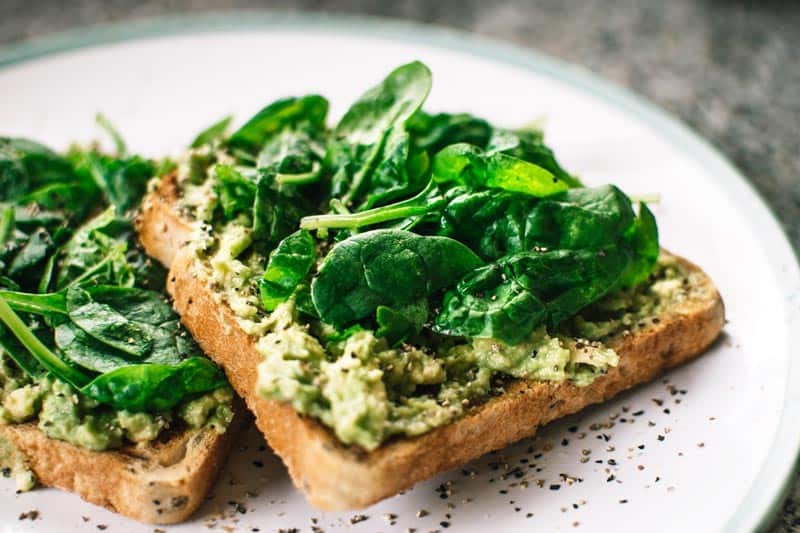Are you looking for meaningful vegan statistics, numbers, facts or studies? Then you've come to the right place! Veganism has developed from a trend to an integral part of our society - for good reasons. But how many vegans are there actually in Germany or worldwide? And what measurable effects do you actually have when you go vegan diet? Are there numbers and statistics? Logical!
In this article I would like to introduce you to the most important statistics, numbers, data and facts from scientific studies and surveys around veganism. Let's go!
Here you can find a brief overview of the statistics article in advance:
Notice: This statistics contribution is part of the Nutrition blogs. Feel free to browse the blog a little more and learn, for example, how you can also stay vegan on vacation can or what delicious, vegan recipes you can try out.
Statistics and facts about vegans in Germany

Let's start right away with the numbers about the people in Germany and the world who live vegan or eat vegan. Here are some relevant statistics about vegans that you can use:
How many vegans are there anyway?
- In Germany: Around 1.5 million people in Germany are vegan or largely abstain from animal products.1 Around 8.1 million people in Germany are already vegetarian.2
- Worldwide: According to conservative estimates, there are around 500 million vegans and over 1 million vegetarians worldwide.3 Adding up the number of vegans, it is therefore correct to say that there are over 1.5 million people who eat at least a vegetarian diet.
What distinguishes vegans?
- Features: The typical vegan is female, in her late 20s or early 30s, and in transition from university to work. He lives with a life partner who is also vegan.₄
- Trade: 92 percent of vegans nowadays find more vegan products when shopping than in the past - in order to also be able to steadily eat vegan.₅
- Motivation: For 61 percent of vegans, animal welfare is the most important motive for their own vegan diet. Only 8 percent cite their own health as the main reason for changing their lifestyle.₆
Facts and figures on vegan consumption

That veganism is an everyday part of our society, one recognizes particularly at the Purchasing and consumer behavior. I have some statistics for you on this as well:
- Milk: More and more people prefer plant-based milk to cow's milk. Global sales rose from the equivalent of 6.6 billion euros in 2010 to around 14.6 billion euros in 2018.₇
- Turnover: While around 208 million euros in sales were generated with vegetarian and vegan foods in 2010, this figure had already risen to 454 million euros by 2015.₈ The rates of increase in sales themselves are also increasing from year to year. From 7.7 percent (from 2010 to 2011), to 14.3 percent (2011/2012), 17.6 percent (2012/2013), 19.9 percent (2013/2014), to 25.9 percent in the comparison between 2014 and 2015.₉
- Restaurants: According to a survey by the ProVeg association, there are now more than 250 purely vegan catering establishments in Germany.₁₀
- Seal: According to a study, around 58 percent of consumers are aware of the V-label, which identifies vegan products. In Germany, there were already 5,000 products in 2016. Across Europe, there are around 10,000 licensed products.₁₁
- Books: In 2012, only 23 books on vegan nutrition were published. In 2016, there were already 211 books.₁₂
Vegan statistics on the reasons for purely plant-based diet
Of course, there are also meaningful numbers about what drives people to eat a vegan diet - whether health, environmental, or ethical. Here are some suitable vegan statistics for you:
How many animals are killed for nothing every year?
- Food waste: Every year, 356 million kilograms of meat are thrown away in Germany. 45 million chickens, 4 million pigs and 200,000 cattle therefore die in vain.₁₃ (Recommendation: Detailed article about world hunger)
Tip: I have given you a Live online counter for killed animals programmed. There you can see how many animals are killed every second for our eating habits.
What are the veganism facts about raising cattle?
- Cattle feed cultivation: About 61.8 percent of arable land in Germany is used to grow livestock feed and only 21 percent is used for direct food production.₁₄
- Cattle breeding: Around the world, about one billion cows graze on the green pastures of this earth today.₁₅ Cattle emit large amounts of methane. The gas is about 25 times more harmful to the climate than the CO2.₁₆ Brazil breeds the world's largest cattle herd with 180 million animals.
- Deforestation: Amazon rainforest in particular is being cleared for the pastures - 100,000 km² from 1996 to 2006 alone.₁₇ More at Factory farming, Deforestation and species extinction.
- emissions: Livestock production accounts for nearly 15 percent of global greenhouse gas emissions, according to the Food and Agriculture Organization of the United Nations (FAO).₁₈ On average, a vegan saves the emission of two tons of greenhouse gases each year, including 670 kilograms of CO2.₁₉
How much water is used for 1 kilogram of beef?
- Water consumption: More than 15,000 liters of water are needed to produce 1 kilogram of beef. Among other things, for watering, cleaning stalls or growing feed.₂₀ See also Environmental problem of water scarcity.
What other facts are crucial for vegans?
- Fishing: Fisheries pull around 90 million tons of fish from the seas for our meals every year.₂₁ See also Statistics on the overfishing of the seas.
- Fish as feed: 40 percent of the fish caught worldwide is fed to livestock.₂₂
- Health: Vegetarians and vegans have a 22 percent reduced risk of coronary heart disease compared to meat eaters, according to a recent study.₂₃
Recommendation: Celebrities are also ensuring that more and more people are opting for the vegan diet through their outreach. In the article about vegan celebrities you'll find out which stars are leading the way.
Valuable studies about veganism

The facts and figures from this article are based on many values from studies. Here you can find some of the most important studies on the subject of veganism:
- National Consumption Study II, Max Rubner Institute, Federal Research Centre for Nutrition and Food.
- Analysis and valuation of the health and climate change cobenefits of dietary change, PNAS, Oxford Martin Programme on the Future of Food, 09.02.2016.
- Risks of ischaemic heart disease and stroke in meat eaters, fish eaters, and vegetarians over 18 years of follow-up: results from the prospective EPIC-Oxford study, BMJ, 2019.
- The Vegan Studies Project: Food, Animals, and Gender in the Age of Terror, Laura Wright, 2015.
- Health and nutritional aspects of sustainable diet strategies and their association with environmental impacts: a global modelling analysis with country-level detail, Oxford Martin Programme on the Future of Food and Centre on Population Approaches for Non-Communicable Disease Prevention, 2018.
- Vegan Nutrition for Mothers and Children: Practical Tools for Healthcare Providers, Scientific Society for Vegetarian Nutrition, 2018.
- Reducing food's environmental impacts through producers and consumers, J. Poore and T. Nemecek, June 2018.
Notice: By the way, I've put together some other statistics posts that you can use to help enlighten our society. Look for example in the contribution about Plastic waste facts and figures or via Climate change statistics over.
Predictions about veganism

Of course, there are also scientific forecasts, which, as always, should be treated with caution. But as a rule, such projections are based on today's, i.e. realistic, conditions.
- All of them are vegan: If everyone in the world ate a vegan diet, about 8 million lives could be saved₂₄, 49 percent of global CO₂ emissions₂₅ and health-related costs, and climate damage of $1.5 trillion could be saved by 2050.₂₆
- Global sales: According to scientific surveys, global sales of meat substitutes and meat alternatives will increase massively in the coming decades and reduce meat consumption. In 2025, meat market sales are expected to reach US$1,080 billion, falling to US$720 billion by 2040. Sales of vegan "meat products" are expected to increase from $120 billion (2025) to $450 billion in 2040. This will be joined by in vitro meat produced in the laboratory, which could generate global sales of 140 billion US dollars in 2030 and as much as 630 billion US dollars in 2040.₂₇
- Agricultural land: Without meat and dairy products, agricultural land worldwide could be reduced by up to 75 percent or used for plant-based nutrition.₂₈
Question: Do you know any other statistics or facts about veganism that should not be missing here? Then feel free to write me a comment.
Use vegan statistics!
Veganism has arrived in the center of our society, that should have become clear after the described data from the most different studies.
Please use the facts, figures and statistics from this article to help other people understand this versatile and especially sustainable way of life. Do you have any questions, tips or suggestions? Then feel free to leave me a comment below this article.
Stay sustainable,

PS.: You can learn more about veganism in the article about the Connection between our diet and the environment. Let you also in the post about the sustainable nutrition inspire. Have fun!
If you use any of the Vegan stats from this post, please credit the following source. Thank you for your support!
https://www.careelite.de/veganismus-statistiken-fakten/References:
₁,₄,₅,₆ Skopos (2016): 1.3 million Germans live vegan, available at https://www.skopos-group.de/news/13-millionen-deutsche-leben-vegan.html. [24.10.2019].
₂,₃ ProVeg e.V.. (2019): Vegan-Trend: Facts and figures on the veggie market (as of 11.01.2019), available at https://proveg.com/de/pflanzlicher-lebensstil/vegan-trend-zahlen-und-fakten-zum-veggie-markt. [25.10.2019].
₇ Bayerischer Rundfunk; PULS Reportage (2019): Plant milk: How easy is it to make soy, almond & oat milk yourself?, YouTube, 24.07.2019, Web, 09.08.2019 at 16:20, in: https://www.youtube.com/watch?v=CxMNascXcHY&list=PLBKJiSqm23i06XfAmH9mL6Pc01i-yZ984.
₈,₁₂ Heise Medien GmbH & Co. KG: Statistic of the week - Food without animal (as at: 13.03.2018), available at https://www.heise.de/tr/artikel/Statistik-der-Woche-Essen-ohne-Tier-3991101.html. [24.10.2019].
₉ Vegan-News.de; IFH Köln (2016): Fleischalternativen im Überblick - Marktentwicklung und Hersteller (Stand: 05.03.2016), available at http://www.vegan-news.de/fleischalternativen-ueberblick-hersteller. [25.10.2019].
₁₀,₁₁ ProVeg e.V.. (2019): Vegan-Trend: Facts and figures on the veggie market (as of 11.01.2019), available at https://proveg.com/de/pflanzlicher-lebensstil/vegan-trend-zahlen-und-fakten-zum-veggie-markt. [25.10.2019].
₁₃ Westdeutscher Rundfunk Cologne: Tons of food in the trash? Vomit! https://www1.wdr.de/verbraucher/ernaehrung/rewind-lebensmittelverschwendung-100.html. [07.10.2019].
₁₄ Forum Moderne Landwirtschaft e. V.: Are the animals eating away our grain? (Accessed July 2016). https://www.moderne-landwirtschaft.de/fressen-die-tiere-uns-das-getreide-weg.[09 Aug. 2019].
₁₅ Statista GmbH: Cattle population worldwide from 1990 to 2019 (in millions of animals) (as of May 24, 2019). , https://de.statista.com/statistik/daten/studie/28931/umfrage/weltweiter-rinderbestand-seit-1990. [09 AUG. 2019].
₁₆ Federal Environment Agency (2019): Greenhouse gases (as of 06.06.2019). https://www.umweltbundesamt.de/themen/klima-energie/klimaschutz-energiepolitik-in-deutschland/treibhausgas-emissionen/die-treibhausgase. [09.08.2019].
₁₇ Umwelthelden e. V. (2015): Meat and soy: Why factory farming threatens the rainforest (as of: 23.05.2015), available at https://www.abenteuer-regenwald.de/bedrohungen/fleisch-soja. [25.10.2019].
₁₈ Food And Agriculture Organization Of The United Nations (FAO, 2014): Tackling climate change through livestock (as of 21.10.2014). http://www.fao.org/ag/againfo/resources/en/publications/tackling_climate_change/index.htm. [09.08.2019].
₁₉ Utopia GmbH: Study: This is how much greenhouse gas vegans save (as of August 2019), available at https://utopia.de/vegan-treibhausgase-co2-137342 [24.10.2019].
₂₀ Federal Environment Agency (2017): Hidden water (as of 22.03.2017). https://www.umweltbundesamt.de/themen/verstecktes-wasser. [09.08.2019].
₂₁ Greenpeace e. V.: The hunt for the last fish. https://www.greenpeace.de/themen/meere/fischerei/die-jagd-auf-den-letzten-fisch. [09.08.2019].
₂₂ Simply Conscious Living: Did you know that 90 percent of the world's soy, 50 percent of the world's grain, and 40 percent of the world's fish caught are fed to farm animals? https://www.simply-live-consciously.com/deutsch/ernährung-ressourcenverbrauch/tierfutterverbrauch. [09.08.2019].
₂₃ T. Tong, P. Appleby, A. Perez-Cornago; BMJ (2019): Risks of ischaemic heart disease and stroke in meat eaters, fish eaters, and vegetarians over 18 years of follow-up: results from the prospective EPIC-Oxford study, available at https://www.bmj.com/content/366/bmj.l4897. [24.10.2019].
₂₄ Springmann, M., Godfray, H., Rayner, M.: Analysis and valuation of the health and climate change cobenefits of dietary change, available at https://www.pnas.org/content/pnas/early/2016/03/16/1523119113.full.pdf. [24.10.2019].
₂₅ Poore, J., Nemecek, T.: Reducing food's environmental impacts through producers and consumers (as of 01 June 2018). https://science.sciencemag.org/content/360/6392/987. [23.10.2019].
₂₆ Springmann, M., Godfray, H., Rayner, M.: Analysis and valuation of the health and climate change cobenefits of dietary change, available at https://www.pnas.org/content/pnas/early/2016/03/16/1523119113.full.pdf. [24.10.2019].
₂₇ Statista GmbH: Forecasted meat market sales of meat substitutes and meat alternatives worldwide from 2025 to 2040 (as of June 03, 2019), available at https://de.statista.com/statistik/daten/studie/426592/umfrage/umsatz-mit-fleischersatzprodukten-in-deutschland. [25.10.2019].
₂₈ Poore, J., Nemecek, T.: Reducing food's environmental impacts through producers and consumers (as of 01 June 2018). https://science.sciencemag.org/content/360/6392/987. [23.10.2019].
- IfD Allensbach: People in Germany who classify themselves as vegans or as people who largely abstain from animal products in the years 2015 to 2023, available at https://de.statista.com/statistik/daten/studie/445155/umfrage/umfrage-in-deutschland-zur-anzahl-der-veganer. [19.12.2023]. ↩︎
- IfD Allensbach: Number of people in Germany who classify themselves as vegetarians or as people who largely abstain from meat¹, from 2015 to 2023, available at https://de.statista.com/statistik/daten/studie/173636/umfrage/lebenseinstellung-anzahl-vegetarier. [19.12.2023]. ↩︎
- Veganivore: Number of vegans in Germany - 140+ facts (2023), available at https://veganivore.de/anzahl-veganer-statistiken-fakten. [19.12.2023]. ↩︎






check your numbers or sources - the numbers are not correct at the back and front!
Moreover, it is not a source citation if this draws the info itself only from another source citation!
THIS IS BASIC KNOWLEDGE!!!!
oh, the source was deleted? Then you should check all sources. quite bumbling... but ok, for those interested it is then enough to embarrass with the "facts" and "half-truths" learned here.
Honestly, as a clear-thinking, halfway intelligent person, you should notice the error immediately. Unfortunately, it looks like you have collected "facts" without checking them.
Quote:
Food waste: Every year, 356 million kilograms of meat are thrown away in Germany. 45 million chickens, 4 million pigs and 200,000 cattle therefore die in vain.₁₃
End
If there were now "only" 4 million pigs, they would weigh less than 100 kg on average - which is roughly equivalent to the slaughter weight - rounded up considerably.
Therefore, the pigs alone cover the throwaway quantity! So it doesn't work! an "Or" doesn't work either.
Which, by the way, sounds so nice lurid - in fact, that's 12 GRAMM per person per day!
But you're good at lurid number twisting.
But well, who can only copy data instead of compiling it himself, as a proper work should be... Study also so expired? Learned only lab science?
Just as altbackene Phrasengedresche with the water consumption with 1kg meat...weißte, you do so smart but that there is the RAINWATER on the surface falling with included, that is underestimated. That makes times just 94% of the share!
Moreover, water is not consumed - another old wives' tale!
Good sources are by the way Statista...and not what you offer here. Maybe also compare several sources from all sides and not use the one-sided propaganda of NGOs! because that's all it is - but yes, in that sense you belong to it!
Come on, here's something factual!
https://www.agrarheute.com/land-leben/1-kg-fleisch-keine-25000-l-wasser-verbraucht-581875
Moin! Bin ja offen für Korrekturen – aber wenn du mir nicht mal eine andere Quelle nennst, die ich prüfen kann, kann ich auch nicht viel machen 😉
Best regards
Christoph
Hi,
the figure of 1.3 million vegans is from 2016, isn't it? Is there also more current data on this?
Danke dir 🙂
Hallo Stefan! Habe bisher keine aktuellere Zahl. Gehe aber davon aus, dass wir 4 Jahre später deutlich über dieser Zahl liegen. Zumal die Bewegung exponentiell stark wächst – und ich auch selbst dazugekommen bin. Einer mehr ist es also auf jeden Fall 😉 Ich aktualisiere die Zahl, sobald es klare Fakten gibt.
Best regards
Christoph
Dear Christoph
Thanks for the powerful post and facts and figures you put together.
Best regards
Fatih
Hey Fatih! Thanks for your feedback, I'm glad if I could help you!
Many greetings,
Christoph
Comments are closed.